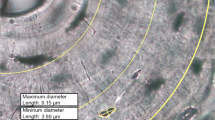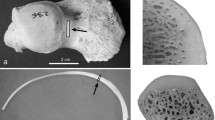Abstract
Osteon structure has been widely studied in mammals, but osteon structure in dogs has received relatively little attention, especially in terms of whether aging has any effect on osteon structure. The aim of this study was to compare the osteon structure of both flat (scapula and os coxae) and long bones (humerus, radius, ulna, metacarpus, femur and tibia) of male puppy and adult Golden Retrievers. We examined five parameters: Haversian canal diameter, Haversian canal area, osteon diameter, osteon area, and number of lacunae per osteon. Our results show that the values for Haversian canal diameter were significantly higher in the os coxae and tibia, but significantly lower in the femur of adult dogs as compared to those of puppies. The Haversian canal diameter of the other bones investigated did not show any significant differences between puppies and adult dogs. The Haversian canal area was significantly greater in the os coxae, radius and femur of adult dogs than in those of puppies. The osteon diameter and area of every bone examined were significantly smaller in puppies than in adult dogs. Lastly, the number of lacunae per osteon showed the same trend as osteon diameter and area. Plexiform bone could be found in three bones in puppies, i.e. the femur, humerus and tibia. Overall, the results of this study should provide basic knowledge on the microanatomy of cortical bone in dogs and on the possible influence age.





Similar content being viewed by others
References
Britz HM, Thomas CDL, Clement JG, Cooper DML (2009) The relation of femoral osteon geometry to age, sex, height and weight. Bone 45:77–83. doi:10.1016/j.bone.2009.03.654
Caccia G, Magli F, Tagi VM et al (2016) Histological determination of the human origin from dry bone: a cautionary note for subadults. Int J Legal Med 130:299–307. doi:10.1007/s00414-015-1271-6
Cattaneo C, Porta D, Gibelli D, Gamba C (2009) Histological determination of the human origin of bone fragments. J Forensic Sci 54:531–533. doi:10.1111/j.1556-4029.2009.01000.x
Chan AHW, Crowder CM, Rogers TL (2007) Variation in cortical bone histology within the human femur and its impact on estimating age at death. Am J Phys Anthropol 132:80–88. doi:10.1002/ajpa.20465
Crescimanno A, Stout SD (2012) Differentiating fragmented human and nonhuman long bone using osteon circularity. J Forensic Sci 57:287–294
Currey JD (1960) Differences in the blood-supply of bone of different histological types. Q J Microsc Sci 101:351–370
Currey JD (1964) Some effects of ageing in human Haversian systems. J Anat 98:69–75
Dammers K (2006) Using osteohistology for ageing and sexing. In: Ruscillo D (ed) Recent advances in ageing and sexing animal bones. In: Proc 9th ICAZ Conference. Oxbow, Oxford, pp 9–39
Dominguez VM, Crowder CM (2012) The utility of osteon shape and circularity for differentiating human and non-human Haversian bone. Am J Phys Anthropol 149:84–91
Havill LM (2004) Osteon remodeling dynamics in Macaca mulatta: normal variation with regard to age, sex, and skeletal maturity. Calcif Tissue Int 74:95–102. doi:10.1007/s00223-003-9038-3
Hidaka S, Matsumoto M, Ohsako S, Toyoshima Y, Nishinakagawa H (1998) A histometrical study on the long bones of raccoon dogs, Nyctereutes procyonoides and badgers, Meles meles. J Vet Med Sci 60:323–326
Hillier ML, Bell LS (2007) Differentiating human bone from animal bone: a review of histological methods. J Forensic Sci 52:249–263. doi:10.1111/j.1556-4029.2006.00368.x
Jee WS, Bartley MJ, Cooper R, Dockum N (1970) Bone structure. In: Andersen AC (ed) The beagle as an experimental dog. Iowa State University Press, Ames, pp 162–188
Jowsey J (1966) Studies of Haversian systems in man and some animals. J Anat 100:857–864
Kim HK, Shiraj S, Anton C, Horn PS (2014) The patellofemoral joint: do age and gender affect skeletal maturation of the osseous morphology in children? Pediatr Radiol 44:141–148. doi:10.1007/s00247-013-2790-2
Manilay Z, Novitskaya E, Sadovnikov E, McKittrick J (2013) A comparative study of young and mature bovine cortical bone. Acta Biomater 9:5280–5288. doi:10.1016/j.actbio.2012.08.040
Martiniaková M, Omelka R, Chrenek P, Vondráková M, Bauerová M (2005) Age-related changes in histological structure of the femur in juvenile and adult rabbits: a pilot study. Bull Vet Inst Pulawy 49:227–230
Martiniaková M, Omelka R, Ryban L, Grosskopf B, Vondráková M, Bauerová M, Fabis M, Chrenek P et al (2006) Comparative study of compact bone tissue microstructure between non-transgenic and transgenic rabbits with WAP-hFVIII gene construct. Anat Histol Embryol 35:310–315. doi:10.1111/j.1439-0264.2006.00690.x
Morales-Avalos R, Leyva-Villegas J, Sánchez-Mejorada G et al (2014) Age- and gender-related variations in morphometric characteristics of thoracic spine pedicle: a study of 4,800 pedicles. Clin Anat 27:441–450. doi:10.1002/ca.22359
Mori R, Kodaka T, Sano T, Yamagishi N, Asari M, Naito Y (2003) Comparative histology of the laminar bone between young calves and foals. Cells Tissues Organs 175:43–50
Mori R, Kodaka T, Soeta S et al (2005) Preliminary study of histological comparison on the growth patterns of long-bone cortex in young calf, pig, and sheep. J Vet Med Sci 67:1223–1229
Mulhern DM, Ubelaker DH (2003) Histologic examination of bone development in juvenile chimpanzees. Am J Phys Anthropol 122:127–133
Nganvongpanit K, Phatsara M, Settakorn J, Mahakkanukrauh P (2015) Differences in compact bone tissue microscopic structure between adult humans (Homo sapiens) and Assam macaques (Macaca assamensis). Forensic Sci Int 254:e1–e5. doi:10.1016/j.forsciint.2015.06.018
Parenteau CS, Wang NC, Zhang P, Caird MS, Wang SC (2014) Quantification of pediatric and adult cervical vertebra—anatomical characteristics by age and gender for automotive application. Traffic Inj Prev 15:572–582. doi:10.1080/15389588.2013.843774
Singh IJ, Gunberg DL (1971) Quantitative histology of changes with age in rat bone cortex. J Morphol 133:241–251. doi:10.1002/jmor.1051330208
Skedros JG, Hunt KJ, Hughes PE, Winet H (2003) Ontogenetic and regional morphologic variations in the turkey ulna diaphysis: implications for functional adaptation of cortical bone. Anat Rec A Discov Mol Cell Evol Biol 273:609–629
Skedros JG, Knight AN, Clark GC et al (2013) Scaling of Haversian canal surface area to secondary osteon bone volume in ribs and limb bones. Am J Phys Anthropol 151:230–244. doi:10.1002/ajpa.22270
Streeter M (2012) The determination of age in subadult from the rib cortical microstructure. Methods Mol Biol 915:101–108. doi:10.1007/978-1-61779-977-8_6
Thompson DD (1980) Age changes in bone mineralization, cortical thickness, and Haversian canal area. Calcif Tissue Int 31:5–11. doi:10.1007/BF02407161
Whitman EJ (2004) Differentiating between human and non-human secondary osteons in human, canine, and bovine rib tissue. Masters thesis.small breed dogs. Masters thesis. Michigan State University, East Lansing
Zedda M, Lepore G, Biggio GP, Gadau S, Mura E, Farina V (2015) Morphology, morphometry and spatial distribution of secondary osteons in equine femur. Anat Histol Embryol 44:328–332. doi:10.1111/ahe.12141
Acknowledgments
The authors wish to acknowledge the Animal Anatomy Museum, Department of Veterinary Biosciences and Public Health, Faculty of Veterinary Medicine, Chiang Mai University, for supplying bones. The authors are also grateful for research funding from Chiang Mai University (CMU) provided to the Excellence Center in Osteology Research and Training Center (ORTC).
Author information
Authors and Affiliations
Corresponding author
Ethics declarations
Conflict of interest
The authors declare that they have no conflict of interest.
Rights and permissions
About this article
Cite this article
Nganvongpanit, K., Pradit, W., Pitakarnnop, T. et al. Differences in osteon structure histomorphometry between puppyhood and adult stages in the Golden Retriever. Anat Sci Int 92, 483–492 (2017). https://doi.org/10.1007/s12565-016-0345-y
Received:
Accepted:
Published:
Issue Date:
DOI: https://doi.org/10.1007/s12565-016-0345-y




